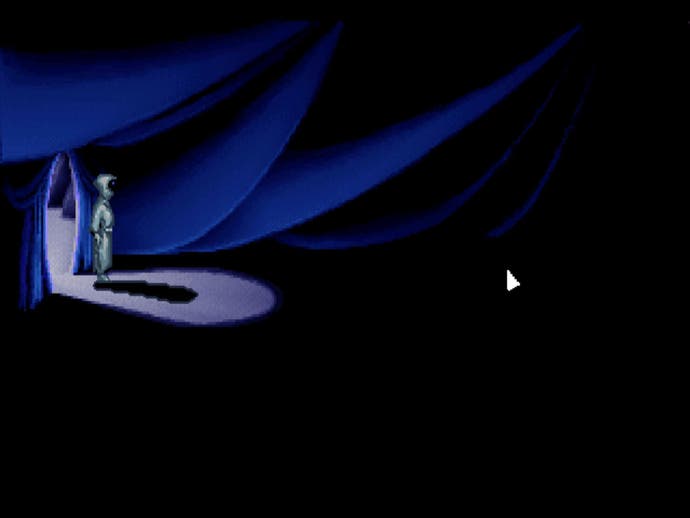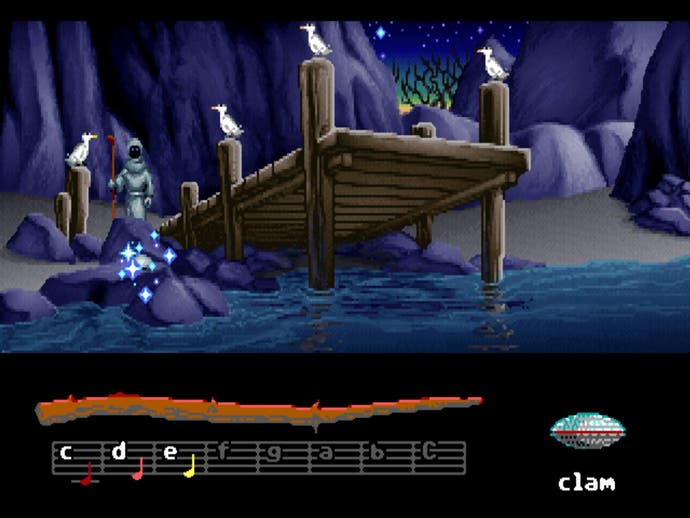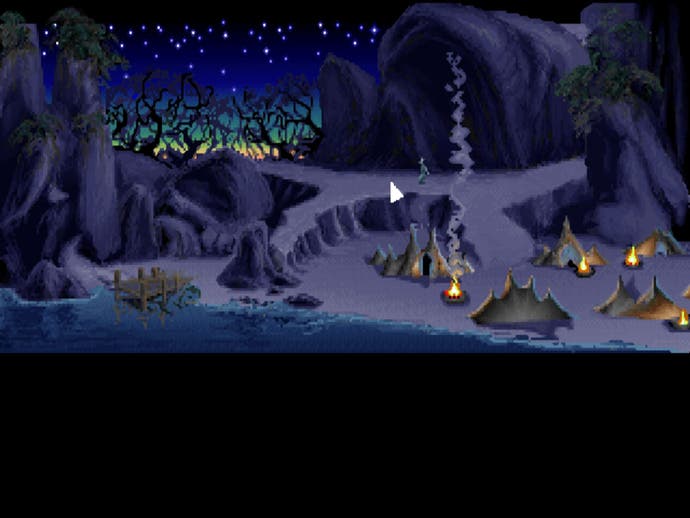LucasArts' Loom is a family-friendly classic with lessons for today's games
Ask me about Loom(TM).
Loom might be one of the most underappreciated games in the LucasArts library. This is a library in which almost every game is considered a classic: Monkey Island is endlessly quotable, Grim Fandango is a noir delight, and even The Dig has plenty of fans. Loom has always struggled for recognition in comparison.
That said, I sense a growing appreciation for Loom among people who write about games. You don't have to look far for essays recognising Loom as a succinct, often beautiful experience that remains singular nearly 35 years after its release. For me, it also provides a bright example of how to create a family-friendly adventure that intrigues adults, doesn't condescend kids, and is driven by a sense of wonder.
The game is the creation of Brian Moriarty, a developer who doesn't have enough credits to his name. His skill is indicated by the fact that Loom was his first foray into graphical adventures following an early career spent working on text-based games such as Wishbringer. Wishbringer was purposefully commissioned by its publisher Infocom to be an accessible introduction to the genre, and the skills needed to strip a genre back and create something streamlined and inviting - not to mention less infuriating than its stablemates - clearly fed into Loom. You can complete Loom in two or three hours without too much in the way of challenge and with no obvious roadblocks. What Loom has instead is atmosphere. It's transporting. It's little wonder that Moriarty was subsequently brought on board to create the story for the Steven Spielberg-produced game The Dig, even if production challenges led to him eventually leaving the project.


(Moriarty's not the only figure playing an important part in Loom's development, of course. With George Lucas behind the studio, it's no coincidence that a strange, unique, and sometimes childlike game came from this particular team. Loom was the result of an environment where experimentation was encouraged as long as money wasn't wasted, and Lucas' support stems from a fascination with the potential of technology and an interest in engaging the minds of children. There are undoubtedly hundreds of thousands of adults like me who benefited from Lucas' work funding the creation of engaging, imaginative worlds to explore.)
Narratively, Loom takes a broad strokes approach. It's set in a fantasy world where the population is split into different guilds. These guilds are geared solely around particularly industries. The glassblowing guild, for instance, has its citizens' language and idioms shaped by glasswork, and there's something of the quirky, comic British approach to fantasy in this idea of these unique characters holed up in their distinct corners of the world. This striking set-up gives an almost biblical feeling to proceedings, too, in that it creates a world of Babel-like divisions between the guilds. This is fertile ground for the story's unashamedly sentimental core.
The sentiment comes from the fable-like journey of its hero, Bobbin Threadbare, the outcast and presumed wunderkind of the weaver's guild. The seventeen-year-old hero is not just a very talented youth, however. An audio drama that accompanied the boxed DOS release of Loom explains that he was created from a magical loom, and his mother was turned into a swan for her role in this.


As Loom begins, Threadbare's guild has been all but swept into oblivion, and he must uncover the reason behind this and save the universe from disaster. As the story evolves, it begins to feel something like a creation myth, pulling at threads of fate, death, and transcendence. It implicitly tackles more grounded ideas too, such as whether it's possible for people to tackle these big questions when stuck in an individualistic world, no matter how skilfully - like the game's guilds - they ply their trades. Such themes could have made Loom complex, but due to that broad approach, the story sticks in the mind, where it works on the player's innate sense of wonder and curiosity.
Fittingly, Loom is genuinely beautiful. The original release was on the Amiga, which made for a very limited colour range, yet it's still mightily impressive to look at. Its reduced colours, in fact, may make it more striking than the overly saturated DOS version. Most important to me are the distinct locations, characters, and careful staging of the scenes. There is the feeling of an epic adventure, despite this being a game that reaches its conclusion while many would still be warming up.
But this is a game where all its elements work elegantly together, and this is perhaps best highlighted by a beautiful score, inspired by Swan Lake. This was particularly important for the original release, as there was no voice acting. As a result of this absence, perhaps, some scenes feel almost transcendental in their mixture of Tchaikovsky's score and Loom's affecting parable.

It's satisfying to play, too, despite that lack of obvious challenge. Indeed, one of the major factors in the adventure game's eventual decline was boredom with increasingly abstruse puzzles and pernickety controls. Loom has largely logical puzzling instead, not requiring players to randomly mash objects together or click all over the screen. Players instead encounter spells, in the form of four-note tunes or "drafts", within the world and have to figure out their correct usage. Sometimes they must use their growing knowledge of the draft system to create entirely new arrangements of spells with entirely new powers. Loom doesn't expect anyone to have to think like a Machiavellian game designer, or a musician for that matter, but from my experience, it leaves adults and children feeling intelligent and engaged. It's playful at its core: you're toying with a handful of notes and rearranging them in interesting ways. It's hard not to be swept along by this.
Family and adult games had less of a clear distinction in Loom's day, meaning that it was easy to find games that could satisfy everyone. Sonic the Hedgehog was beloved by players of all ages. British releases like Lemmings, Worms, and Theme Hospital had a wry humour that encouraged many types of player to get involved. Of course, none of these games had much in the way of narrative. Yet even something story-led like Final Fantasy 7 felt nicely pitched to young and old with its balance of cute models, high energy, and deep themes.
Unfortunately, younger players are now often seen as mini-consumers, expected to vacuum up all the Lego games, beg their parents for Fortnite skins, and play through slapdash content on Roblox. It makes the '90s seem particularly worthy of nostalgia, considering that even the edutainment games of the era were good, showing a genuine respect for children and their time. George Lucas, once again, was one of the rare contributors to this field with his Lucas Learning division, putting out games like the physics-inspired Star Wars: Droidworks. Droidworks dropped in 1998, incidentally, the same year that Half-Life and Metal Gear Solid landed and pushed gaming towards more adult experiences with a narrative focus.
Today feels like a perfect moment for Loom to get another chance. Many older games are making a comeback and showing how intriguing and playful this earlier era could be. Tomb Raider I - III Remastered has had an enormously positive reception across the board, even though it can seem so out of step with modern titles. Grim Fandango, similarly, might have awkward puzzles, yet its remaster showed it's still compelling and unique and people value that.

Loom's most complete version has never seen release outside of Japan, and so a Western version could be a proper chance for the game to be more than an obscure cult treat. It deserves it. As it stands, Loom is both a timeless adventure and a reminder of a lost approach to design.
There isn't a direct equivalent of LucasArts any more, a developer and publisher given free reign by a billionaire owner to produce games focused on wonder and wit. Loom's short and memorable. It stays with players long after the credits have rolled. Listen closely and it's creation myth seems to tell us that no aspect of the past is truly lost forever.
